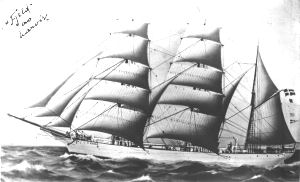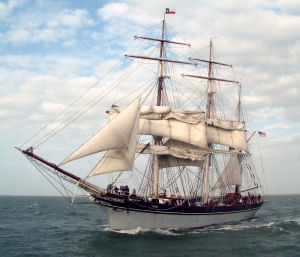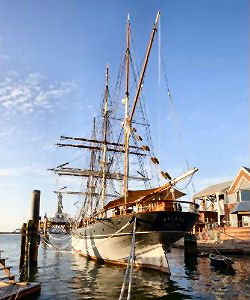
HOME
INTRO
SYMBOLS
ALMANAC
ECONOMY
GEOGRAPHY
STATE MAPS
PEOPLE
FORUM
NEWS
COOL SCHOOLS
STATE QUIZ
STATE LINKS
BOOK STORE
MARKETPLACE
NETSTATE.STORE
NETSTATE.MALL
GUESTBOOK
CONTACT US


Tweet
Double click any word in document for definition.
Texas State Tall Ship

Texas Tall Ship: Elissa as Fjeld (1912)
The Galveston Historical Foundation made a purchase in 1975.
For $40,000 they obtained a 205 foot, badly rusted, iron-hulled ship that was on the verge of being scrapped. It was named Pioneer.
Back in 1961, marine archeologist Peter Throckmorton had stumbled upon this same vessel while on business in Piraeus, Greece. Mr. Throckmorton saw beyond the years of modernization, including a modified bow, a deckhouse and bridge, installation of engines, and altered rigging coupled with failed maintenance. His experienced eye recognized the mongrel for what it was; the hull of a late 19th century sailing ship.
The captain of the Christophoros invited Throckmorton aboard. Throckmorton's suspicions were confirmed when he found the ship's original builder's plate. It read "Alexander Hall & Company, No. 294, Aberdeen, 1877." Throckmorton wrote to Alexander Hall & company, still in business, and confirmed that the vessel had been built in 1877 as the square-rigged sailing ship Elissa.
On July 20, 1980, 94 years after her last visit, the Elissa arrived in Galveston.
It is reported that the Elissa’s (then named Achaios) last productive days were spent smuggling cigarettes from Yugoslavia to Italy.
In 1970 the ship, now named Pioneer, was seized by Greek authorities and Throckmorton learned that the ship was going to be scrapped. Time was off the essence if the vessel was to be saved.
Unknown to Throckmorton, Karl Kortum, Director of the San Francisco Maritime Museum, now the San Francisco Maritime National Historic Park, had been working, since 1964, to secure the Elissa for preservation. Peter Sanford, president of the South Street Seaport Museum, New York, brought Throckmorton and Kortum together.
Acting as Kortum’s agent, Throckmorton returned to Greece. Deals were negotiated and the rusting hulk was purchased by the San Francisco Maritime Museum for $13,500.
Unfortunately San Francisco could not afford to restore her, and Elissa sat, still rusting, in Greece. If the ship were to be saved, another benefactor had to be found.
Kortum found a man, David Groos, a Wisconsin-born member of the Canadian Parliament, who could help. He purchased the Elissa in 1972 and plans were initiated to bring the wasting vessel to Victoria, British Columbia for restoration. Groos ran into difficulties lining up supporters and died of cancer shortly after the purchase. The Elissa, still sitting in Greece, was put up for sale again.
This is where Texas enters the story through a tangled web of circumstances. Michael Creamer, who ran the ship model shop at New York’s South Street Seaport Museum and Texan Paul Gaido approached Peter Brink, executive director of the Galveston Historical Foundation. As the foundation was involved in the restoration and preservation of 19th century Galveston properties, Creamer and Gaido thought the foundation might also be interested in a sea-going property. They told him that the Elissa had visited Galveston twice in the late 19th century.
- 1883 – first visit, unloaded bananas and picked up cotton and headed for Liverpool, England.
- 1886 – second visit, unknown cargo, most likely hardwood or sugar. Sails for Pensacola, Fla.
Brink thought the presence of a 19th century sailing ship would be the perfect complement to the 19th century neighborhood that the association was restoring about a block away. On October 2, 1975, the Galveston Historical Foundation purchased the Elissa.
For their $40,000, the Galveston Historical Foundation had obtained ownership of a vessel originally built as a three-masted, iron hull sailing ship in Aberdeen, Scotland. Commissioned by Liverpool, England merchant Henry Fowler Watt and built by Alexander Hall & Co, the Elissa was launched on October 27, 1877.
In 1977, the foundation sent a team to Greece to prepare the Elissa for her journey to Galveston.
- March 21, 1978 - Elissa is placed on the National Register of Historic Places; the first object granted this status while outside the territorial limits of the United States.
- 1978 - Twenty-five percent of her original iron hull renewed and bow restored, Elissa is towed to Gibraltar.
- 1978-1979 - Elissa winters in Gibraltar at the Royal Navy Yard.
- July 20, 1979 - 93 years after her last visit, the Elissa arrives in Galveston.
- August 4, 1979 – Official welcoming ceremony.
- July 4, 1982 - Elissa sails in the Gulf of Mexico out of Galveston.
- December 4, 1990 – Elissa named a National Historic Landmark.
- March 18, 2005 - House Concurrent Resolution No. 117 filed by Representative Craig Eiland.
- June 8, 2005 - Governor Rick Perry signs House Concurrent Resolution No. 117, naming Elissa the "official tall ship of Texas."
H.C.R. No. 117
HOUSE CONCURRENT RESOLUTION
WHEREAS, The history of Texas is not complete without recognition of the ships, seaports, and maritime heritage that contributed so greatly to the development, economy, immigration, and culture of the state in the 19th century, and the state's preeminent symbol of this thrilling bygone era is the tall ship Elissa; and
WHEREAS, In the 1970s, the city of Galveston was looking for a ship to complement the restoration and redevelopment of the Strand, known in the 1800s as the Wall Street of the South, and to help Texans recognize and interpret the state's maritime heritage; and
WHEREAS, Constructed in 1877 in Aberdeen, Scotland, Elissa is a three-masted, iron-hulled tall ship of the "barque" type, measuring 205 feet long and 99 feet, 9 inches high at the mainmast, with a cargo capacity equivalent to that of eight railroad boxcars; and
WHEREAS, Elissa transported a variety of goods around the world over the course of her more than 90 years of commercial history, first calling at Galveston in December 1883 with a cargo of bananas and one passenger, then sailing for Liverpool, England, with a cargo of cotton, and calling at Galveston again in September 1886 with a cargo of what was probably lumber or sugar and sailing for Pensacola, Florida, in ballast; and
WHEREAS, Built at the dawn of the steamship era, Elissa filled a niche in maritime commerce, calling on many ports, and she was sold from owner to owner, sailing under different names before being readied for the scrap yards of Piraeus, Greece, where she was recognized by a maritime archeologist; and
WHEREAS, Elissa was acquired by the Galveston Historical Foundation in 1975, and after some initial work in Greece, she was towed in 1978 to the Royal Navy yard in Gibraltar; that same year, Elissa was placed on the National Register of Historic Places, becoming the first object to achieve this status while outside the territorial limits of the United States; and
WHEREAS, In 1979, Elissa returned to Galveston, her former port of call and new home, and intensive efforts began to raise funding and restore her to her 1877 sailing configuration; that goal achieved, Elissa sailed again on the Gulf of Mexico in September 1982; and
WHEREAS, Elissa is preserved and maintained by her volunteer crew, who donate thousands of hours annually and sail her at least once a year to preserve the seamanship skills of square-rig handling for future generations, providing guests with the rare opportunity to sail on a historic vessel; and
WHEREAS, Restored to her former glory as a seaworthy sailing ship, Elissa is an irreplaceable piece of living history, and her stature is underscored by her designation as one of "America's Treasures" by the National Trust for Historic Preservation and as a National Historic Landmark; and
WHEREAS, Elissa, with the support of the Texas Seaport Museum, provides students and the public with a rare opportunity to visualize the maritime heritage and culture of Texas and its coastal waters; and
WHEREAS, Even today, the sight of Elissa in full sail evokes the color and excitement of the age of sailing ships, and this vibrant reminder of an essential piece of our shared history, representing Texas, is indeed deserving of special recognition; now, therefore, be it
RESOLVED, That the 79th Legislature of the State of Texas hereby designate Elissa the official tall ship of Texas.

Texas State Tall Ship: Elissa
Photograph: Galveston Historical Foundation
- 2011 - Elissa declared not seaworthy by U.S. Coast Guard. $3,000,000 project kicked off to repair and restore Elissa.
- January 28, 2013 – Elissa returns to birth at the Texas Seaport Museum in Galveston after spending three months in dry dock to have new iron plates welded on her hull and new wooden decking installed.
Texas Law

1877 Tall Ship Elissa in Galveston, Texas
16" by 20" Giclee Photgraphic Print
by Carol Highsmith
Elissa was declared the official tall ship of the State of Texas by House Concurrent Resolution and is not, therefore, listed in the Texas Statutes.
Only a small number of Texas' myriad symbols have been actually adopted by an act of the legislature and written into the Texas Statutes.
Sources...
Voss, Kurt D. Galveston's The Elissa: The Tall Ship of Texas. Mount Pleasant: Arcadia Publishing, 2009. Print.
"History of Elissa." Galveston Historical Foundation. Galveston Historical Foundation. Web. 29 Mar 2013.
"1877 Tall Ship Elissa." Galveston Historical Foundation. Galveston Historical Foundation. Web. 29 Mar 2013.
"1877 Tall Ship Elissa, The Official Tall Ship Of Texas, To Return To Galveston Historical Foundation’s Texas Seaport Museum." Galveston Historical Foundation. Galveston Historical Foundation. Web. 29 Mar 2013.
Additional Information
1877 Tall Ship Elissa: Presented by the Galveston Historical Foundation.
Texas Seaport Museum: A project of the Galveston Historical Foundation.
State watercraft: Complete list of official state watercraft from NETSTATE.COM
More symbols & emblems: Complete list of official Texas state symbols from NETSTATE.COM.

Sailing Ship Elissa, by Patricia Bellis Bixel. 122 pages. Publisher: Texas A&M University Press (November 22, 2011)
Centennial Series of the Association of Former Students, Texas A&M University. Patricia Bellis Bixel is currently an associate professor of history at Maine Maritime Academy in Castine, Maine. JIM CRUZ, a freelance professional photographer, was a member of the Elissa crew for many years.

Galveston's The Elissa: The Tall Ship of Texas, by Kurt D. Voss. 128 pages. Publisher: Arcadia Publishing (November 9, 2009)
For nearly three decades, the 1877 sailing ship Elissa has been widely recognized as one of the finest maritime preservation projects in the world. Unlike some tall ships of today, the Elissa is not a replica but a survivor. Over her century-long commercial history, she carried cargoes to ports around the world for a succession of owners. Her working life as a freighter came to an end in Piraeus, Greece, where she was rescued from the salvage yard by a variety of ship preservationists who refused to let her die. The story of Elissa’s discovery and restoration by the Galveston Historical Foundation is nothing short of miraculous.

